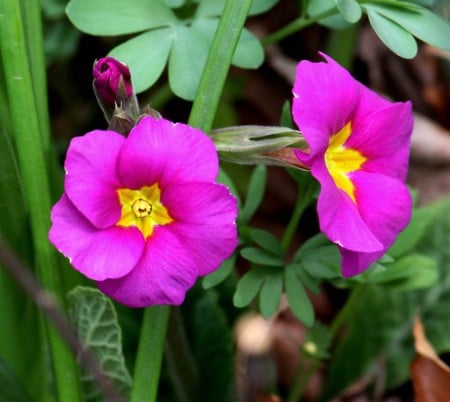The generosity of seed companies is a wonderful thing. Last year, I had a packet of Primula polyanthus seeds, the kind of colourful primula sold in small pots during the cold weeks of late winter. I planted the whole contents of the packet indoors and under lights, and ended up with 275 primulas to nurture and find homes for. This taught me that it’s okay not to start all the seeds in a packet; holding some back for the next year might be a good idea.

Last spring, I was planting primulas for a long time, and even mailed some to my friend Clare, who has assisted in previous plant excesses. Despite the time and effort it took to get all those primula seedlings in permanent homes, I’m quite pleased to see their bright green, crinkled leaves and thick stems of flower buds popping up everywhere. Primulas emerge with such infectious exuberance, that just seeing them pumps up my own energy.
If planted in part shade and rich organic soil, they continue flowering for six weeks. A sudden heat wave can shut them down, but they’ll carry on to the end of May if temperatures remain seasonal. Primulas like cool air, consistent moisture and good drainage. They can last for several years, or until they run into an icy winter. Sitting under ice seems to be their nemesis, but we don’t get much winter ice given our current weather patterns.
If you wanted to start primulas from seed, the time for that is mid-winter. But you can always take the shortcut in early spring and purchase the brightly coloured plants that are often found in supermarkets. Enjoy the flowers indoors, and when the plant stops blooming, put the pots on a cool windowsill and continue watering to keep the foliage going. You can pop them into garden beds as soon as the soil can be worked, and they’ll be with you for years. The same can be done with forced pots of tulips, hyacinths and narcissus—continue to water after the flowers are finished and grow in a cool indoor location with light, then plant in the garden in spring. Once the pots of plants and bulbs are planted outdoors, feed once with a balanced fertilizer, such as 7-7-7 or 10-10-10 (or any similar analysis that’s close to balanced), and water if the soil becomes dry.
I grow a batch of primulas every winter, and this year I have little seedlings of Primula polyneura (Zone 5, possibly Zone 4 with protection under mulch). I received the seed from membership in the Ontario Rock Garden and Hardy Plant Society (onrockgarden.com), and I also ordered some from Chiltern Seeds (chilternseeds.co.uk). They make a lovely rosette of heavily crimped, light green foliage, and clusters of bright pink flowers with yellow eyes on eight-inch (20-cm) stems. The leaves, covered in fine hairs, have a velvety texture, and are every bit as pretty as the flowers. These do well in light shade to part sun, and like all other primulas, must have consistent moisture in summer (so place them with other plants you always water).
And, yes, I learned my lesson, and planted only half the packet. I have just 32 little Primula polyneura seedlings under lights, waiting for their garden debut.
Other posts by Judith this week:
Posts by Judith last week:
